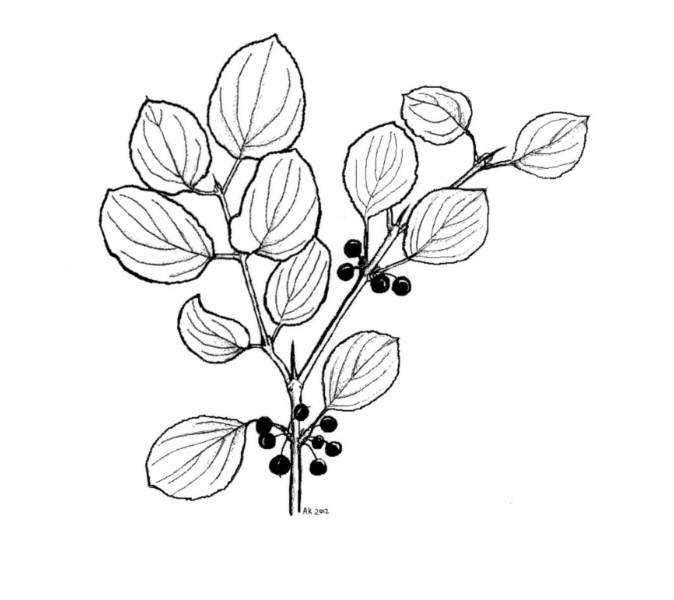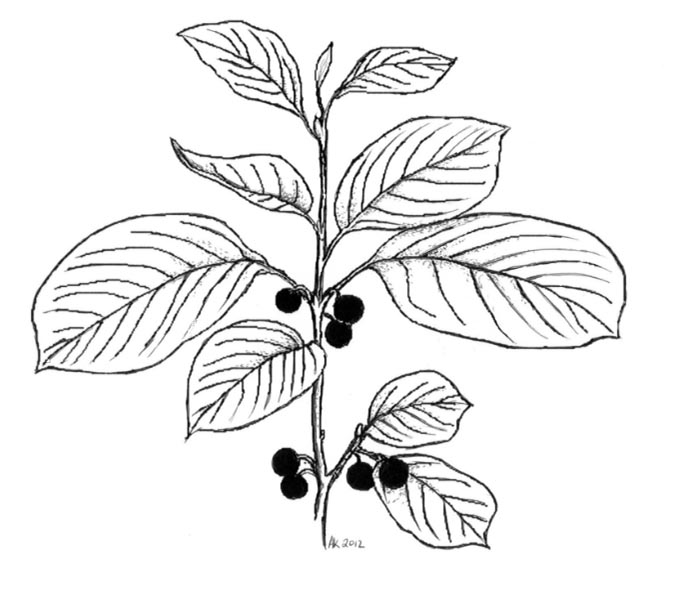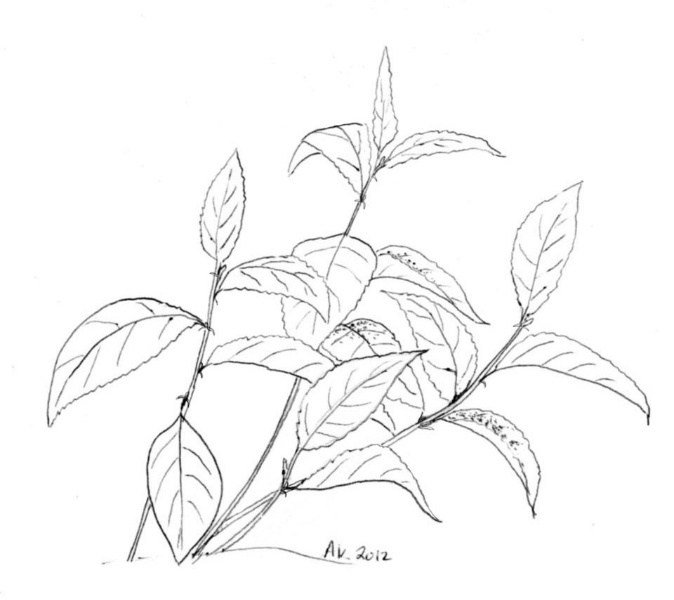Background
Common buckthorn (also known as European buckthorn) is a small shrub or tree native to Eurasia. It was introduced to North America in the 1880s as an ornamental shrub and was widely planted for fencerows and windbreaks in agricultural fields. Since then it has spread aggressively throughout southern Ontario and in other provinces. Common buckthorn can thrive in a wide range of soil and light conditions, enabling it to invade a variety of habitats. It is most often found in woodlands and open fields, where it forms dense stands under which few other plants can grow. Buckthorn can spread widely with the help of birds and animals that eat its fruit, carry the seeds long distances and deposit them in their droppings. Stands of buckthorn can invade roadsides, riverbanks, mature forests, farm fields and hydro corridors.
Range
Outside its native range, common buckthorn is found in Canada as far west as Saskatchewan and as far east as Nova Scotia. It also grows throughout the northeastern and north central United States.
Impacts of Common Buckthorn
- Buckthorn thrives in a variety of habitats and forms dense thickets that crowd and shade out native plants. It can alter nitrogen levels in the soil, creating better conditions for its own growth and discouraging the growth of native species.
- It produces large numbers of seeds that germinate quickly and prevent the natural growth of native trees and shrubs.
- The shrub can host oat rust, a fungus that causes leaf and crown rust and affects the yield and quality of oats.
- The soybean aphid, an insect that damages soybean crops, can use buckthorn as a host plant to survive the winter. Because it can affect agricultural crops, common buckthorn is listed as a noxious weed under Ontario’s Weed Control Act.
How to Identify
- Buckthorn is usually the first shrub to leaf out in the spring and the last to drop its leaves late in the fall.
- It often grows 2-3 m (6.6-9.8 ft) tall. Occasionally it reaches 6 m (19.7 ft), with a trunk up to 25 cm (9.8 in) in diameter.
- Smooth, dark green leaves are finely toothed, 2.5-6 cm (1-2.4 in) long, and arranged in opposing pairs along the stem.
- Most branches older than one year end in a short, sharp thorn.
- Flowers have two to six small yellowish-to-green petals.
- Common buckthorn produces clusters of berry-like black fruit in late summer and fall.
Common buckthorn resembles another invasive species, glossy buckthorn (Frangula alnus), and a much smaller native shrub, alder-leafed buckthorn (Rhamnus alnifolia). Check the chart below to identify common buckthorn, glossy buckthorn and alder-leaved buckthorn.
INVASIVE
Common buckthorn
(Rhamnus cathartica)
Details
- Grows in drier areas
- Often two to three metres tall; can reach six metres
- Twigs end in sharp thorn
- Usually opposite leaves with finely toothed edges
INVASIVE
Glossy buckthorn
(Frangula alnus)
Details
- Grows in wet areas
- Often two to three metres tall; can reach six metres
- No sharp thorn on end of twig
- Alternate, shiny leaves with smooth, wavy edges
What You Can Do
- Learn how to identify common buckthorn, glossy buckthorn and other invasive plants, and how to effectively manage these species on your property. The guide to Best Management Practices for Invasive Common Buckthorn describes the most effective and environmentally safe control practices for this species.
- Avoid using invasive plants in gardens and landscaping.
- Buy native or non-invasive plants from reputable garden suppliers. See Grow Me Instead: Beautiful Non-Invasive Plants for Your Garden.
- Dispose of invasive plants in the garbage. Do not put them in the compost or discard them in natural areas. Discarded flowers may produce seeds.
- When hiking, prevent the spread of invasive plants by staying on trails and keeping pets on a leash.
- If you find Common Buckthorn or other invasive species in the wild, please contact the Invading Species Hotline at 1-800-563-7711, or visit EDDMapS to report a sighting.
Gallery
OFAH/OMNRF Invading Species Awareness Program. (2021). Common Buckthorn. Retrieved from: www.invadingspecies.com.
This factsheet may be reproduced for non-commercial purposes.
Header photo by Ryan Hodnett, Wikimedia, CC BY-SA 4.0





